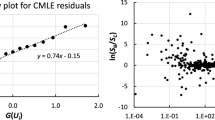Abstract
Magnetic resonance absorption lineshapes can have subtle dependencies on the model parameters that specify the lineshape. To quantify how the model parameters influence the lineshape, it is useful to study simple model systems for which analytical expressions are available. We propose that information theory is a useful tool to quantify how well model parameters may be inferred from a noisy signal. Information theory also allows us to assess the importance of missing parameters from an incomplete model. We do this by monitoring the magnitude of a partition function determined from a suitably defined probability mass function as the model parameters are varied. The optimum parameter set makes the partition function a maximum, which establishes a computable criterion for determining the best model parameter set. Given the availability of a partition function, one may define thermodynamic functions such as the entropy. The optimum parameter set in this interpretation corresponds to the state of maximum entropy. In this work, we observe that at sufficiently low signal to noise ratio, the entropy landscape has no clear maximum, while a related quantity, the Fisher information, always has a clear minimum at the optimum parameter set. The qualitative information we are able to gather from the entropy landscapes is also difficult to assess when the parameters are far from their optimum values, at least for the model system studied here.


















Similar content being viewed by others
References
K.A. Earle, L. Mainali, I.D. Sahu, D.J. Schneider, Appl. Magn. Reson. 37(1–4), 865–880 (2010)
G. Pake, J. Chem. Phys. 16(4), 327–336 (1948 )
A. Abragam, The Principles of Nuclear Magnetism (Oxford University Press, London, 1961)
D.S. Sivia, J. Skilling, Data Analysis: A Bayesian Tutorial (Oxford University Press, New York, 2010)
R.R. Ernst, J. Magn. Reson. 3, 10–27 (1969)
A. Isihara, Statistical Physics (Academic Press, New York, 1971)
E.T. Jaynes, Bayesian Methods: General Background (Cambridge University Press, Cambridge, 1985), pp. 1–25
R. Baierlein, Atoms and Information Theory, vol. 1 (W.H. Freeman and Company, New York, 1971)
A. Ben-Naim, A Farewell to Entropy: Statistical Thermodynamics Based on Information (World Scientific Publishing Co., Pte. Ltd., Singapore, 2011)
C.R. Rao, Bull. Calc. Math. Soc. 37, 81–91 (1945)
J.n.M. Lee, Riemannian Manifolds: An Introduction to Curvature (Springer, New York, 1997)
Acknowledgments
We thank Professor Kevin Knuth of the University at Albany Physics Department for his input on the parameter optimization algorithm design and for many fruitful discussions on aspects of Information theory. This work was partially supported by a University at Albany, Faculty Research Award Program grant. K.A.E. also thanks the National Biomedical EPR Center at the Medical College of Wisconsin where part of this work was done for the use of their facilities during a visit supported by the Advanced Visitors Training Program.
Author information
Authors and Affiliations
Corresponding author
Rights and permissions
About this article
Cite this article
Hock, K., Earle, K. Information Theory Applied to Parameter Inference of Pake Doublet Spectra. Appl Magn Reson 45, 859–879 (2014). https://doi.org/10.1007/s00723-014-0566-y
Received:
Published:
Issue Date:
DOI: https://doi.org/10.1007/s00723-014-0566-y




